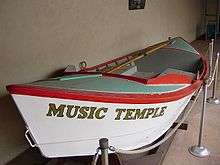Kenton Grua
Kenton "Factor" Grua (July 25, 1950 – August 25, 2002)[1] was a Grand Canyon river guide. He was the first person in recorded history to hike through the Grand Canyon's entire length. In 1983, he set the speed record for rowing through the canyon in 37 hours, which has yet to be broken.
Background

|
| |
|
| |
|
| |
|
|
Kenton Grua was born and raised in Utah. At age 12, Grua was enthralled by a whitewater rafting trip taken with his father on the Green River, a tributary of the Colorado River.[2] He began college around 1968, but soon dropped out after he was offered a job as a motorman—
Years ago, his pals nicknamed him 'Factor' because that's what he was ... this additional element you always had to factor in whenever you were on a river trip, or in the warehouse, or anywhere with him ... frequently brilliant, sometimes insane, usually intense ... always a factor.[2]
Rowing speed-record through the Grand Canyon
In 1983, Grua, along with river guides Rudi Petschek and Steve Reynolds, set a record for speed rowing down the 277-mile length of the Colorado River through the Grand Canyon, with a time of 36 hours, 38 minutes and 29 seconds, breaking the previous record of just under 48 hours set in 1980 by Grua, Petschek, and Wally Rist, which in turn broke the record of 52 hours established in 1951 by the Rigg brothers.[2][5] Normally, trips in motorized rubber rafts take up to a week and dory trips two weeks or more. Grua's 1983 trip took advantage of record-setting seasonal flood waters to propel a specially modified wooden dory called the Emerald Mile along the route. This famous speed run has been recounted in a number of books and articles, including Lew Steiger's story "Speed" in Christa Sadler's book, There's This River ... Grand Canyon Boatman Stories (2006),[6] and Kevin Fedarko's The Emerald Mile: The Epic Story of the Fastest Ride in History Though the Heart of the Grand Canyon (2013).[4]
First walk of the Grand Canyon's length
Kenton Grua was the first person in recorded history to walk the entire length of the Grand Canyon.[4] The Colorado River forms the base of the canyon and he walked along or near it from the northern terminus at Lee's Ferry to the southern terminus at Grand Wash Cliffs.[7] Grua first had the idea after reading Colin Fletcher's best-seller The Man Who Walked Through Time (1968) in which Fletcher hiked the length of the Canyon inside Grand Canyon National Park, the first person to do so.[4] However, this was only about half the length of the canyon, because at the time Fletcher conducted his trip in 1963, the National Park did not include the entire length of the canyon (it was later expanded). Others had hiked large portions of the canyon in multiple sections over a number of years. Grua wanted to "do it right" by hiking the entire canyon in a single trip.[4]
Grua's work as a professional river guide allowed him to scout potential routes, which he did for a number of years before his first attempt in the fall of 1971—
Grua reached the end of the canyon, Grand Wash Cliffs, on April 4, 1977, exactly five weeks after he had begun.[4] He estimated he had actually hiked about six hundred miles because of the circuitous route required by the canyon's treacherous topography and the need to return to the river periodically for drinking water. Unlike Fletcher (who wrote a best-selling book and became a hiking icon), Grua did little to publicize his accomplishment, which went largely unnoticed until much later, other than among his fellow river guides.[4] Elias Butler (2007) said it was "one of the greatest hiking accomplishments in Grand Canyon history, though he has received little publicity for it."[7]
Death and legacy
In 1988, Grua founded and was the first president of Grand Canyon River Guides, "a non-profit educational and environmental organization that weighs in on issues ranging from operation of Glen Canyon Dam to uranium mining near the rim, from overflight noise to quiet motors."[8]
Grua died at 52 years of age from a heart attack related to a fall from his mountain bike on lower Schultz Creek Trail, near his home in Flagstaff, Arizona.[9] He was survived by his wife and step-children.
The Whale Foundation offers the Kenton Grua Memorial Scholarship,[10] benefiting Grand Canyon river guides who are pursuing further education.
References
- ↑ "Kenton 'Factor' Grua". Arizona Daily Sun. August 26, 2002. Retrieved July 21, 2014.
- 1 2 3 4 Lew Steiger (Winter 1997–1998). "Kenton Grua". Boatman's Quarterly Review. Retrieved July 22, 2014.
- ↑ Ton Wharton (April 22, 2010). "Utah river rafting pioneer Ted Hatch dies at 76". The Salt Lake Tribune. Retrieved July 24, 2014.
- 1 2 3 4 5 6 7 8 9 10 11 Kevin Fedarko (2013). "Chapter 10: The Factor". The Emerald Mile: The Epic Story of the Fastest Ride in History Though the Heart of the Grand Canyon. Scribner.
- ↑ Rachel Martin (May 12, 2013). "Chasing A Dream, Speeding Down 'The Emerald Mile'". NPR. Retrieved July 21, 2014.
- ↑ Christa Sadler (2006). "Speed". There's This River ... Grand Canyon Boatman Stories. This Earth Press.
- 1 2 Elias Butler (2007). Grand obsession: Harvey Butchart and the Exploration of Grand Canyon. Puma Press. p. 260.
- ↑ "Grand Canyon River Guides". Retrieved July 22, 2014.
- ↑ Brad Dimock (August 27, 2002). "Re: Kenton Grua dead". Yahoo Groups: Grand Canyon Hikers. Retrieved July 21, 2014.
- ↑ "Kenton Grua Memorial Scholarship". Whale Foundation. Retrieved July 21, 2014.